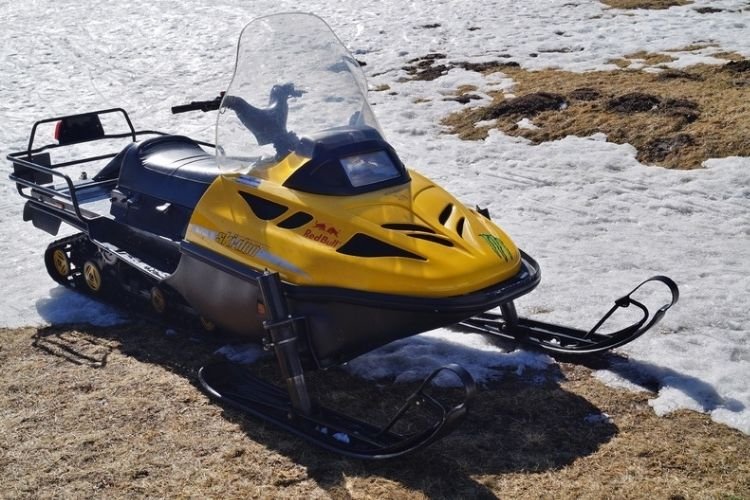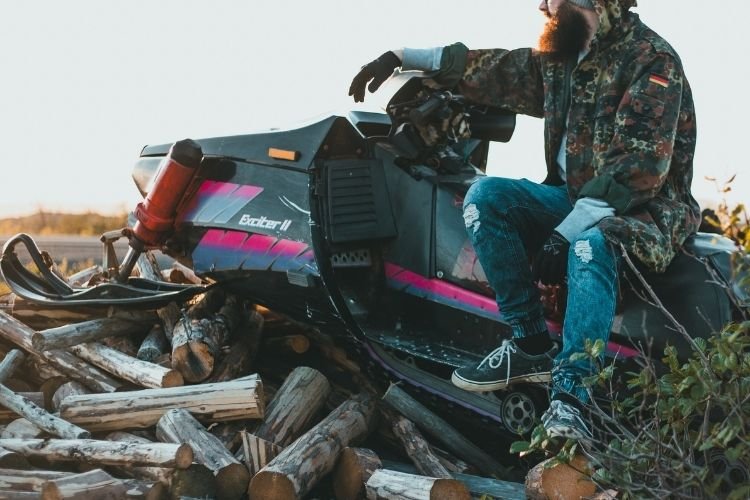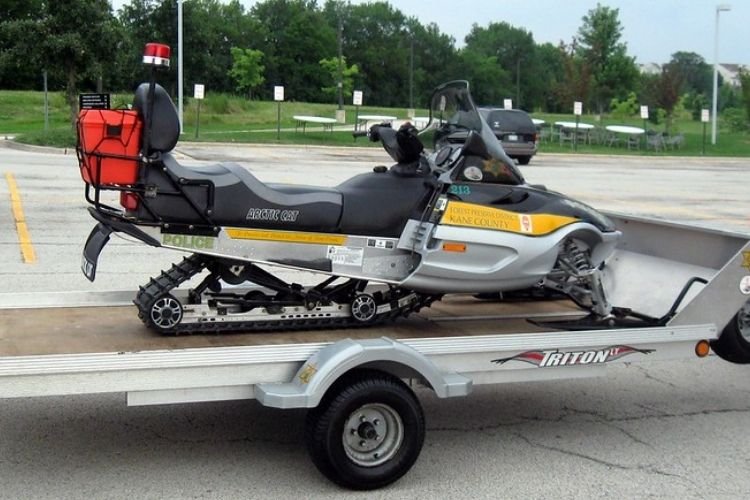Motorcycle safety relies on mirrors for riders to keep tabs on what's going on around them. Yet, not every mirror cuts it the same way. Riders have long been bickering over which is better: bar end mirrors or the stock mirrors. They argue about which (Bar End Mirrors vs Stock Mirrors) gives a better view, […]

How to Summerize a Snowmobile? 8 Tips to Storage Better
Lots of owners let their snowmobiles quit at the end of a season's last trip, and also there they are on the lawn all springtime, summer season, and for the world to see.
Even if you aren't so irresponsible, just car park your snowmobile in a garage and unloading a little fuel stabilizer in the gas container isn't adequate to fend off snowmobile wear.
Unprotected from the elements, they break down. Gas hoses harden, seat textiles fracture and also rust forms on internal engine elements.
How to Summerize a Snowmobile?
Snowmobiles should have been better. Get the 10 tips to store snowmobiles better.
Constantly follow your snowmobile manufacturer's suggestions when saving your snowmobile in the summer season. Failure to execute straightforward jobs can lead to headaches and expensive repair work when the time does come to fire up your snowmobile once more.
Table of Contents
1. Treat the Fuel with Stabilizer
Recognizing which gas stabilizer to utilize for your particular application is a must and will aid keep the gas in your machine fresh, removing bothersome efficiency troubles following the period.
Gas consists of solvents that make it unstable, however when those solvents evaporate, the vapors climb from the carburetor dish and might cause some steels to wear away.
The environment-friendly gunk that you might have seen in the dish of a carburetor is the residue of gas and rusted metal that ran down the within the carburetor and settled at the lowest factor.
Gas-infused engines do not generally experience this condition due to the fact that throttle bodies, usually, are impermeable.
Gas stabilizers are made to lower the evaporation of solvents that make gas volatile.
While using excessive stabilizer won't necessarily hurt the fuel system, gas additives inherently minimize the octane ranking of gas by minimizing the concentration, so follow the instructions on the container to add the right amount of stabilizer in relation to just how much fuel remains in the storage tank.
After you pour the fuel stabilizer into the container, slosh it around and run the engine for a few minutes so cured gas moves with the system.
2. Do Proper Cleaning
Make the effort to wash your snowmobile eliminating last season's belt dirt and any other dirt/grime you might have picked along your travels.
A good layer of wax will maintain it resembling brand-new. Do not neglect to layer any areas that can rust with lubes.
Likewise, a clean snowmobile is a fantastic way to search for cracks in the framework, suspension, and so on. This is one of the factors race snowmobiles are spotless on a daily basis.
To cleanse the snowmobile, first I as to take the exhaust off (connect the manifold with a paper towel and either tape over the opening or zip-tie a baggie or more to stop dampness from entering your engine.
Then remove the belt. As soon as this is done, tape off the intake to avoid water from going into the engine.
When you have this done, locate a self-serve car and truck wash or a pressure washing machine (warmth is a bonus offer if you can).

3. Oil Change
Oil is the life-blood of your snowmobile, particularly if you run a 4-stroke.
Numerous makers suggest changing the oil at the end of the period to eliminate the contaminants, as they will have an unfavorable impact on the inner operations of your engine.
4. Grease The Framework
To help keep the suspension and steering systems working smoothly, pump a couple of shots of grease right into each zerk on the chassis.
This pushes out water from within the small shafts and also suspension tubes, and also loads those small gaps with oil so moisture won't collect inside tubes during the temperature level cycles of very early springtime and also late autumn.

5. Dry Storage Space
Possibly the most vital summerizing step is to find an incredibly completely dry place for your snowmobile.
A common motif in avoidance is to stay clear of wetness buildup.
You can perform this by taking your snowmobile off the ground and placing it onto a lift to maintain your back suspension in prime condition.
Likewise, be sure to cover your snowmobile snugly to avoid accumulating dirt.
6. Fog The Engine
Talk with a person from practically any kind of crankshaft repair shop and also they'll claim that finishing the within a snowmobile's engine with storage space fogging oil is vital to avoid engine failing.
This thin layer of oil protects components like linking rods, pole pins, cylindrical tube walls and also crankshaft bearings from the air and also moisture, which will certainly or else interact to create deterioration that makes those components prone to failure.
You might know a person who fires up his or her snowmobile every couple of weeks throughout the summer season to keep the fuel relocating and spread out a little oil with the engine, yet that's not ample to guarantee great crankshaft security.
Revving an engine or letting it still for a couple of mins most likely will not get it warm enough to burn off dampness inside either, and it might promote much more water vapor to collect on the crankshaft and within the exhaust system.
Get to the engine's carburetors or throttle bodies by getting rid of or dismantling the airbox and pulling out the foam or air horns.
In some cases, you may be able to peel back the carburetor boots in order to give the fogging oil an unblocked course from the canister to the intake.
Eliminating the airbox varies from brand name to brand and also a version to model.
It's rather simple to access the throat of carburetors or throttle bodies on older snowmobiles, but much more recent equipment is challenging as a result of limited rooms that are loaded with cords, hose pipes, and cable televisions.
Job meticulously as you get rid of components and make note of their alignment.
With the engine running, spray fogging oil right into the engine.
Splash the oil at each intake for a few seconds at a time, and then switch over to the other cylindrical tube while at the same time pressing the throttle lever to maintain the engine running slightly over idle speed.
Remain to spray oil into the engine-- alternating cylinders every few seconds-- for concerning a minute, or up until thick, white smoke comes out of the exhaust.
Allow it to sputter and also close down. If the engine has carburetors, shut off the fuel button and also get rid of the drain plugs to allow the gas to drain.
This, in addition to the fanning stabilizer, helps in reducing the possibility of troubles with the gas system in the fall.
Spraying storage fogging oil through the intake of a four-stroke engine will certainly aid secure the camera shaft, shutoffs and also various other elements in the cylinder head, but Arctic Feline, for example, especially says not to mist its 1100cc engines.
If you're prepping a four-stroke engine for the off-season, check the owner's guidebook to learn whether you need to do this step.
The manual could also suggest that you change the oil and filter.

7. Protect Precious Metals
If you want, clean the snowmobile with soap and water to recover its display room sparkle.
Laundering is a must-do if the maker was carried on an open trailer in order to remove corrosive salt and roadway gunk.
Spray WD-40 or similar, lightweight oil on steel surface areas: the exhaust, A-arms, rear suspension rails, chain case cover, cylindrical tubes and cylinder head.
Liberally apply the oil on those components to put a barrier against corrosion, however make certain it doesn't get in touch with the clutches or drive belt.
When you draw the snowmobile out of storage space in the loss, wash it with a light degreaser like Basic Environment-friendly to get rid of the oily polish.
8. Remove the Battery
With the rate of our little Powersports batteries, it's extremely crucial to keep them in a secure location away from radical temperature level modifications and also to maintain them at some kind of low cost.
When you've prepped your snowmobile for the summer season, eliminate the battery and location it in a completely dry location (possibly a storage space wardrobe in the garage) and also connect a flow battery charger (.5 amps or less).
Do you have to Summerize a snowmobile?
I have actually seen sleds that don't get the proper service done and also are stored with no treatment included. Typically it becomes a sled that won't start, broken components throughout the first flight, and much in expenditures. You know How Much is a Snowmobile so protect your sled.

Motorcycle mechanic, writer. Interested in motorcycle gear for years. Like to stay up to date with the newest products and techniques of the motorcycle.
Picking the perfect brake pads for your ride has an influence on how safe you are, how well your whip handles, and what you’ll shell out over time. You’ve got a whole menu, from wallet-easy organic pads to fancy ceramic or semi-metallic types. To get why budget brake pads ain't the same as the pricier […]
E-bikes have transformed into more than just gadgets to help you get around. Now, they're speed demons that can go toe-to-toe with motorbikes. It’s 2025, and these speedy machines have gotten a huge boost from better motors, more powerful batteries, and sleek designs that cut through the air like a knife. Let’s dive into the […]
Many riders who aren't so tall or ladies just starting to ride bikes need to pick out the best Motorcycles for Short Riders and Women. They gotta look for three key things: a seat that's not too high up, a bike that's not too heavy, and something that looks good enough to give them confidence. […]
As we accelerate into 2025, motorbikes are getting a serious tech upgrade. They’re all about safer rides and more fun on the road. Even if you’re a pro or just starting, kitting out your two-wheeler with cool tech stuff is a game-changer. Check out these ten top motorcycle gadgets each motorcyclist will want in 2025. […]
Getting around the city every day can be super annoying. You've got traffic like molasses nowhere to park, fuel prices through the roof, and buses stuffed like sardine cans make heading to the office a real pain. For loads of folks, getting a motorcycle is a pretty slick move—they’re nimble, cost-effective, and perfect for squeezing […]

